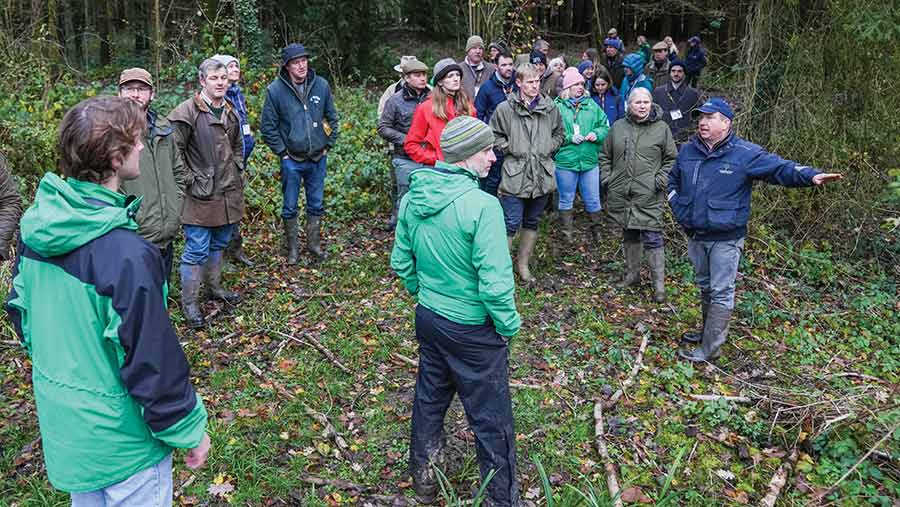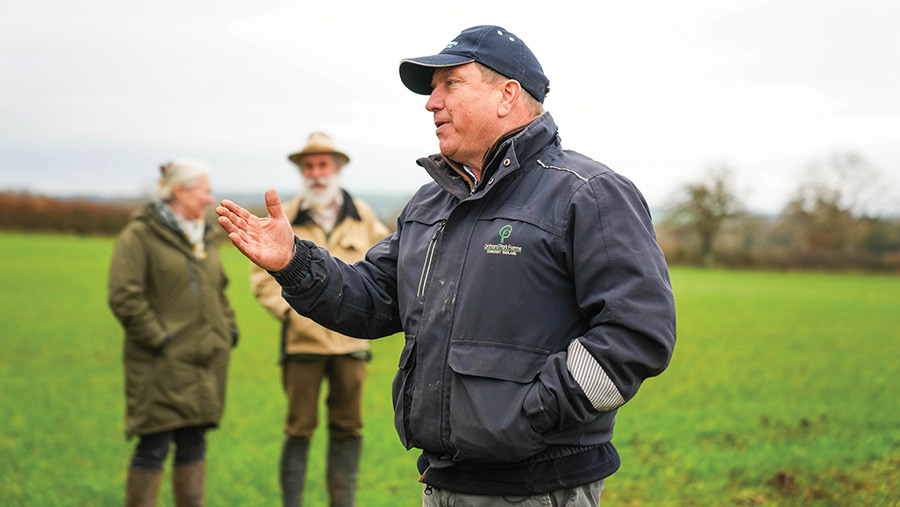Woodland creation – tax, legal and practical advice
 © Emily Fleur
© Emily Fleur By 2050, 16.5% of the UK will be covered by trees – that is the government’s aspiration.
Tree cover currently sits at 10% in England, so there is some way to go and that’s why some of the financial incentives, such as the England Woodland Creation Offer (Ewco), are at their most generous ever.
Some landowners, including third-generation mixed farmer Neil Macdonald, have embraced this.
See also: Renewable energy investment on farm – what to expect and what to avoid
He is planting 13.3ha of grassland at Orchard Park Farm, near Shepton Mallett, with native broad-leaf trees, funded by an Ewco grant.
However, farmers must often find the cash upfront to get the work done before grants are paid.
Diversifying into woodland on a commercial scale has implications for some tax reliefs too.
At the recent Farmers Weekly event Woodland Creation at Orchard Park Farm, experts offered advice on the considerations.
England Woodland Creation Offer
Integrating trees on farms can help mitigate some of the effects of climate change on livestock and soils.
Jo Garlick, land use adviser at the Forestry Commission, said last summer’s intense heat, followed by the autumn deluge, had shown the importance of trees and hedges for shade and shelter.
“Flooding, cold and snow all have an effect on our animals and can lead to mortality.
“However, if you plant trees in the right place they are part of the solution,” she said, pointing out that the grants available are the most generous they have ever been.
In England, to get landowners started there is the Woodland Creation Planning Grant, which is capped at £30,000 and open to landowners with 5ha of land, with a minimum block of 0.5ha for planting.
The England Woodland Creation Offer, administered by the Forestry Commission, covers standard capital costs up to £10,200/ha and stackable payments of up to £8,000/ha for projects that support wider benefits to society, nature recovery and the environment.
Finance and planning
Grants are an important source of funding, but Marc Liebrecht, head of forestry and arboriculture at Carter Jonas, warns that woodland schemes should never be grant-driven.
Landowners should first consider if trees fit with their objectives and if grants can help deliver those.
“I am a big believer that schemes shouldn’t be driven by the grants that are available.
“Look at what you want to do – is the woodland for amenity, shelter, diversification or a combination of some or all of these – and then tap into the grants,’’ said Marc.
Consider any planting constraints, and species suited for the site and purpose.
The Forestry Commission’s map browser is useful for working out land sensitivities, access and other constraints.
It has a woodland creation tool to assess the scope for additional payments.
While technology is useful, practical groundwork is also important, said Marc.
“I recommend going out and sticking a spade in the ground to establish soil type and moisture regime.
“Gather as much historical information as you can for that site, and then go to the tool to produce a geo-reference list of all the species that are compatible with that site.”
Spacing, stocking density and planting patterns are the next consideration, while an important constraint is the availability of young trees.
“Tree availability is a big issue at the moment. Nurseries are slowly gearing up, but there hasn’t been enough trees to match demand, so speak to your nurseries early on in the process.”
Grant eligibility
It is critical that the necessary paperwork and due diligence is completed at an early stage when planning a grant application.
This can be done on the Rural Payments Agency (RPA) site, or the equivalent agency in the devolved UK countries.
“There have been many times when we have submitted an Ewco application and were advised by the RPA that the parcel wasn’t registered for entitlements,” Marc explained.
Another common issue is when tenants have entered the land parcel into a different scheme, but haven’t notified the landlord or agent.
This can seriously delay finalising and approval of the scheme.
“In some cases these are permanent options, but others can be moved. Speak to the RPA to see if they can be taken out and adjusted,” said Marc.
The applicant or, where applicable, any counter-signatories must have full management control of the parcel and it must not be the subject of any disputes.
The parcel must not already be classified as a woodland or, in the case of Ewco, in a grant agreement that has more than five months left to run at the time of submitting the application.
If the land or part of it is in an environmental stewardship agreement it may be possible to transfer the land into Ewco if certain conditions are met.
Tax
The tax regime for woodland, particularly commercial forestry, is advantageous, but there can be pitfalls associated with the loss of generous reliefs available to agriculture.
Commercial woodland is outside the scope of tax, so there is no tax to pay on income from the sales it generates.
On the flip side, no tax relief can be claimed on expenses incurred in establishing and managing commercial woodland.
If the woodland is classified as amenity or short-rotation coppice, income from the sale of wood is taxable because it is part of the general farming business.
Rental income from sporting or recreational activities such as paintballing is taxable because it is not part of the forestry enterprise.
Provided there is an intention to generate taxable supplies from a woodland, it can be registered for VAT on day one and the costs associated with planting, infrastructure and equipment can be recovered, said Nicholas Smail, farms and estates partner at accountant Hazlewoods.
If the woodland is part of a wider VAT-registered farming business it will not need to be separately registered for VAT.
“It may be some time before you reach the threshold of £85,000, but that doesn’t matter because you have that intention at some point in the future to make taxable supplies,” said Nicholas, who listed other considerations:
- How HMRC views grant payments depends on how they are described by the funding body
- If the grant provides an income to replace farming income that would have been generated from that land, that part of it is taxable
- If the landowner sells the woodland the trees are not subject to capital gains tax (CGT), but any gain on the underlying land is, which can raise interesting valuation questions
- CGT rollover relief applies if woodland is sold and the money invested in land used in a farming or other trading business, with the tax paid at some point in the future when that land is eventually sold or gifted
- If the woodland is gifted – for succession planning, for example – holdover relief can be claimed, with the tax again paid when the recipient sells it
- Business asset disposal relief (formerly entrepreneur’s relief), will reduce the CGT rate from 20% to 10% for up to £1m of gain.
For inheritance tax (IHT), business property relief (BPR) applies to commercial woodland, providing 100% relief. To qualify for BPR, the business must be wholly or mainly trading (at least 51%).
Shelter belts and amenity woodland will qualify for agricultural property relief (APR) provided these are part of an agricultural business.
When neither BPR nor APR applies, there is another option – Woodland Relief. This exempts the value of the trees from IHT, but not the value of the underlying land.
Woodland creation can potentially affect APR on the farmhouse. To qualify for APR, the house must be occupied for the purposes of agriculture and be of an appropriate character.
“If too much of the farm is put down to woodland, there is a risk that you are no longer occupying the farmhouse for agriculture and HMRC will say that it is no longer character appropriate, so you could lose APR on the farmhouse,’’ warned Nicholas, adding that tax advice should be sought on individual circumstances when planning woodland projects.
Event host: Orchard Park Farm
Neil Macdonald says getting professional advice and support to submit a woodland creation grant application is critical.
“As farmers, we are juggling so many things that we need to seek professional advice – we don’t have all those skills.
“Find yourselves a good strategic partner, like I have done with the Farming and Wildlife Advisory Group [Fwag], it is absolutely critical.”

Neil Macdonald © Emily Fleur
Neil had already established a 40ha apple orchard at Orchard Park Farm, a 113ha holding he bought 12 years ago.
His Fwag membership gave him access to support to plan for planting a further 13.3ha with native broad-leaf trees with an England Woodland Creation Offer (Ewco) grant.
This land had been earning him £198/ha a year in rent from graziers.
The plan was developed with advice from Fwag South West farm environment adviser Thomas Mansfield.
It took 25 months from applying to the Forestry Commission for a Woodland Creation Planning Grant, which supports the design of the new woodland, to planting the first trees in March 2023.
“Two years isn’t a long time if you consider the longevity of the enterprise you are entering into, and if it means that you think about it more carefully and put it together with a bit more accuracy, it is probably not the end of the world.”
The Forestry Commission said the process now takes less time.
Finding the money for the scheme before the grant is paid can be the biggest barrier, said Neil.
“It is all very well picking up these grants, but someone has to come up with the cash to do it in the first place.
“If we hadn’t been able to break it down into smaller parcels, we wouldn’t have been able to afford to do it.”
The scheme will be completed in 2025, with additional income streams to the grant payments needed to make the project financially viable.
“We have to be very creative beyond the grants, maintenance payments and other bits and pieces. Those alone are not going to pay the bills, so we have to think more broadly,’’ said Neil.
Alternative Land Uses
The Woodland Creation event was part of the series of events – Alternative Land Uses – a partnership between Farmers Weekly and land experts.
The headline partner for Woodland Creation was the Forestry Commission.
